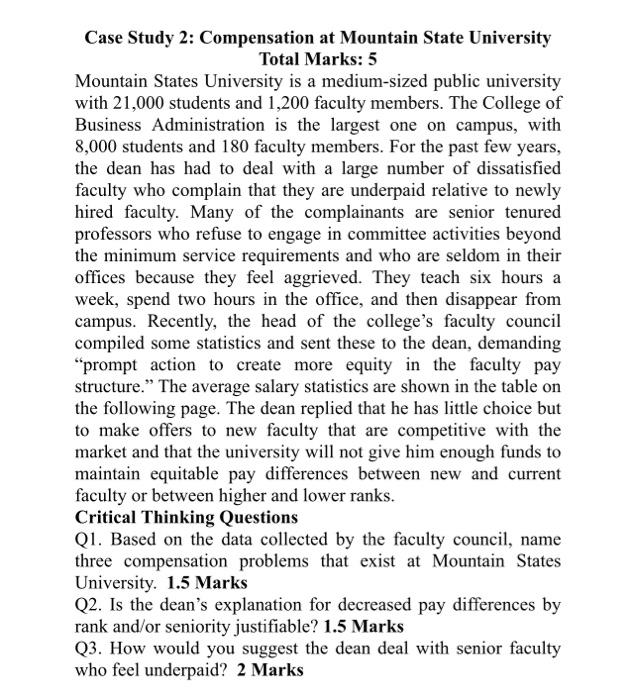Case Study 2: Compensation at Mountain State University Total Marks: 5 Mountain States University is a medium-sized public university with 21,000 students and 1,200 faculty members. The College of Business Administration is the largest one on campus, with 8,000 students and 180 faculty members. For the past few years, the dean has had to deal with a large number of dissatisfied faculty who complain that they are underpaid relative to newly hired faculty. Many of the complainants are senior tenured professors who refuse to engage in committee activities beyond the minimum service requirements and who are seldom in their offices because they feel aggrieved. They teach six hours a week, spend two hours in the office, and then disappear from campus. Recently, the head of the college's faculty council compiled some statistics and sent these to the dean, demanding "prompt action to create more equity in the faculty pay structure." The average salary statistics are shown in the table on the following page. The dean replied that he has little choice but to make offers to new faculty that are competitive with the market and that the university will not give him enough funds to maintain equitable pay differences between new and current faculty or between higher and lower ranks. Critical Thinking Questions Q1. Based on the data collected by the faculty council, name three compensation problems that exist at Mountain States University. 1.5 Marks Q2. Is the dean's explanation for decreased pay differences by rank and/or seniority justifiable? 1.5 Marks Q3. How would you suggest the dean deal with senior faculty who feel underpaid? 2 Marks Case Study 2: Compensation at Mountain State University Total Marks: 5 Mountain States University is a medium-sized public university with 21,000 students and 1,200 faculty members. The College of Business Administration is the largest one on campus, with 8,000 students and 180 faculty members. For the past few years, the dean has had to deal with a large number of dissatisfied faculty who complain that they are underpaid relative to newly hired faculty. Many of the complainants are senior tenured professors who refuse to engage in committee activities beyond the minimum service requirements and who are seldom in their offices because they feel aggrieved. They teach six hours a week, spend two hours in the office, and then disappear from campus. Recently, the head of the college's faculty council compiled some statistics and sent these to the dean, demanding "prompt action to create more equity in the faculty pay structure." The average salary statistics are shown in the table on the following page. The dean replied that he has little choice but to make offers to new faculty that are competitive with the market and that the university will not give him enough funds to maintain equitable pay differences between new and current faculty or between higher and lower ranks. Critical Thinking Questions Q1. Based on the data collected by the faculty council, name three compensation problems that exist at Mountain States University. 1.5 Marks Q2. Is the dean's explanation for decreased pay differences by rank and/or seniority justifiable? 1.5 Marks Q3. How would you suggest the dean deal with senior faculty who feel underpaid? 2 Marks







